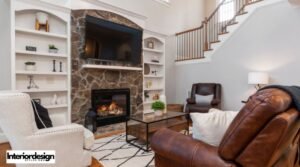Interior design is an art form that reflects personal taste, functionality, and a sense of harmony. It transforms spaces into havens of comfort, style, and personality. Whether you’re revamping your living room, bedroom, or office, understanding various interior design styles can help you create a space that suits your needs and preferences. This comprehensive guide explores different interior design styles and their unique characteristics to help you choose the best fit for your home or workplace.
What Are Interior Design Styles?
Interior design styles are overarching themes or aesthetics that guide the decoration, arrangement, and functionality of a space. Each style has its unique elements, including color palettes, furniture choices, textures, and decorative accents. These styles often draw inspiration from cultural, historical, and environmental influences, allowing homeowners and designers to express individuality through design.

Popular Interior Design Styles
1. Modern Interior Design
Modern design emphasizes simplicity, functionality, and clean lines. It often incorporates neutral colors like white, black, and gray, complemented by bold accents. Minimalist furniture, open spaces, and an absence of clutter are hallmarks of this style.
Key features of modern design:
- Sleek, streamlined furniture.
- A focus on natural materials such as glass, metal, and wood.
- Open floor plans and ample natural light.
2. Contemporary Design
Often confused with modern design, contemporary design reflects current trends and evolves over time. While modern design adheres to a fixed aesthetic from the mid-20th century, contemporary interiors embrace fluidity and flexibility.
Key features of contemporary design:
- A mix of textures and materials, such as concrete and velvet.
- Neutral and monochromatic color schemes with bold accents.
- Dynamic use of lighting and artistic decor pieces.

Traditional Design: A Nod to Elegance
Traditional interior design draws from European styles of the 18th and 19th centuries. It emphasizes elegance, symmetry, and classic details, offering a timeless aesthetic.
Key features of traditional design:
- Ornate furniture with intricate carvings.
- Rich color palettes, including deep reds, golds, and greens.
- Heavy drapery, patterned textiles, and antique accessories.
Rustic and Farmhouse Styles: Nature-Inspired Coziness
Rustic Design
Rustic interiors embrace natural, unrefined elements. This style highlights raw materials like wood and stone, creating a warm and inviting atmosphere.
Key features of rustic design:
- Exposed wooden beams and stone walls.
- Neutral earthy tones and natural fabrics.
- Handmade furniture and vintage decor.
Farmhouse Design
Farmhouse style offers a modern take on rustic design, blending traditional elements with contemporary touches. It’s known for its warmth and comfort, often incorporating shiplap walls, open shelving, and vintage-inspired fixtures.
Key features of farmhouse design:
- White and neutral color palettes with pops of color.
- Reclaimed wood furniture and industrial accents.
- Cozy textiles like quilts and area rugs.
Bohemian (Boho) Style: Free-Spirited Expression

Bohemian design is all about creativity, individuality, and eclectic charm. It incorporates vibrant colors, layered textiles, and an assortment of patterns.
Key features of Bohemian design:
- A mix of global influences, including Moroccan rugs and Indian prints.
- Low seating options like poufs and floor cushions.
- A relaxed, carefree vibe with plenty of plants and personal artifacts.
Minimalist Design: Less Is More
Minimalism takes inspiration from modern design but pushes simplicity to its limits. The mantra of minimalist interiors is “less is more,” focusing on functionality and eliminating excess.
Key features of minimalist design:
- Neutral color schemes, particularly whites and grays.
- Uncluttered spaces with clean, sharp lines.
- Multi-functional furniture with hidden storage solutions.
Industrial Style: Urban Edge
Industrial interior design celebrates raw and unfinished elements, drawing inspiration from warehouses and factories. It’s a popular choice for loft apartments and urban dwellings.
Key features of industrial design:
- Exposed brick walls, ductwork, and metal pipes.
- Utilization of reclaimed wood and industrial lighting fixtures.
- A mix of rugged textures and sleek modern furniture.
Coastal Style: Breezy and Relaxed
Coastal interiors bring the essence of the beach into your home. With light, airy spaces and a calming color palette, this style promotes relaxation and tranquility.
Key features of coastal design:
- White, blue, and sandy hues dominate the color scheme.
- Natural materials like wicker, rattan, and linen.
- Nautical decor, such as seashells, driftwood, and ocean-inspired artwork.
Mid-Century Modern: Retro Revival
Mid-century modern design is characterized by its sleek, functional furniture and organic shapes. Popularized in the mid-20th century, it continues to be a favorite for its timeless appeal.
Key features of mid-century modern design:
- Furniture with clean lines and tapered legs.
- A mix of materials, such as wood, leather, and glass.
- Bold accent colors like mustard yellow, teal, and burnt orange.
Scandinavian Design: Functional Beauty
Scandinavian interiors focus on simplicity, functionality, and a cozy ambiance known as “hygge.” This style blends modern aesthetics with natural elements.
Key features of Scandinavian design:
- Soft, neutral color schemes with an emphasis on white.
- Functional furniture with clean lines.
- Cozy textiles, such as sheepskin throws and wool rugs.
Choosing the Right Style for Your Space

When deciding on an interior design style, consider your personal preferences, lifestyle, and the functionality of the space. Here are some tips:
- Assess Your Needs: Determine how you’ll use the space and what elements are essential.
- Consider the Architecture: Choose a style that complements your home’s structural features.
- Mix and Match: Don’t be afraid to combine elements from different styles to create a unique look.
Final Thoughts
Exploring different interior design styles opens up a world of creativity and self-expression. Whether you prefer the simplicity of minimalist design, the elegance of traditional interiors, or the laid-back charm of coastal styles, there’s something for everyone. By understanding the characteristics of various styles, you can make informed decisions and craft a space that truly feels like home.



